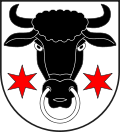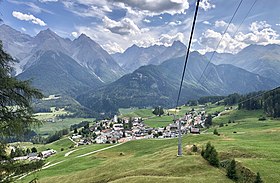Ftan
| Ftan | ||
|---|---|---|
| State : |
|
|
| Canton : |
|
|
| Region : | Engiadina Bassa / Val Müstair | |
| Political community : | Scuol | |
| Postal code : | 7551 | |
| former BFS no. : | 3761 | |
| Coordinates : | 814500 / 186400 | |
| Height : | 1648 m above sea level M. | |
| Area : | 43.08 km² | |
| Residents: | 506 (December 31, 2013) | |
| Population density : | 12 inhabitants per km² | |
| Website: | www.ftan.ch | |
|
Ftan |
||
| map | ||
|
|
||
Ftan ( , German and until 1943 officially Fetan ) is a village in the municipality of Scuol , which is in the Sur Tasna district in the Inn district of the Swiss canton of Graubünden .
Until December 31, 2014 Ftan was an independent political municipality . On January 1, 2015, Ftan was merged with the four municipalities of Ardez , Guarda , Sent and Tarasp into the municipality of Scuol.
geography
The place Ftan is at 1650 m . The area of Ftan extends from the Inn at 1200 m to the Augstenberg at 3230 m . The two largest districts are the closely neighboring settlements of Ftan Grond and Ftan Pitschen. The names mean “Gross-Ftan” and “Klein-Ftan” in German.
history
In 2007, archaeologists from the University of Zurich, led by Thomas Reitmaier, found traces of prehistoric people in Plan da Mattun in Val Urschai, who are up to 10,500 years old. On the Muot Padnal there was a fortified settlement with ramparts and moats as well as a circular wall on the Umbrain hill from the Bronze and Iron Ages. Finds from Roman times are proven in Val Tasna, which also show early alpine economic use.
In the 12th century, the Lords of Tarasp had many goods in Ftan and made donations to the monasteries Müstair and Scuol, and after its relocation to the Marienberg Abbey in Vinschgau . The time when the parish church of St. Peter was built is unknown, but the parish of Ftan has been documented since 1492. In 1499 and 1622 Ftan was destroyed by Austrian troops. In 1542 the transition from the Catholic to the Reformed faith took place. In 1652 Ftan bought itself out of Austria and until 1851 belonged to the judicial community of Untertasna.
Martin Peider Schmid recorded his precise observations on Ftan in a two-volume manuscript called Chiantun verd in the 1770s . Ftan was devastated several times by avalanches (1682 and 1720) and by village fires (1723, 1794 and 1885). In 1875 avalanche barriers and afforestation began. To save the Ftan Grond part of the village from the risk of slipping, the unstable moraine soil of the Palüds da Sainas was drained. Since the construction of the Engadiner Talstrasse from 1860 to 1862, Ftan has been largely cut off from main traffic, as a result of which the population decreased from 506 to 403 between 1850 and 1900. Some Ftaner families emigrated as café animals and confectioners and bought corresponding shops in Italy, Northern and Eastern Europe.
In the important agriculture, arable farming was gradually abandoned in favor of livestock farming. In 1970 the first chair and ski lift was built; after that, winter tourism increased rapidly, which was particularly evident in the construction of numerous holiday apartments.
Attractions
- reformed Church
- House of Vulpius
population
languages
Despite a small German-speaking minority which remained Ftaner the Vallader , a Romansh dialect, until the beginning of World War II faithful (1880 89%, 1900 92% and in 1941 86%). After that, the majority language began to decline by 1980. Since then, a narrow Romansh-speaking majority has been able to assert itself. The language, supported by the community and school, is even gaining ground again (68% understood Romansh in 1990, and even 76% in 2000).
The following table shows the development over the last few decades:
| Languages in Ftan | ||||||
| languages | 1980 census | 1990 census | 2000 census | |||
| number | proportion of | number | proportion of | number | proportion of | |
| German | 139 | 31.95% | 153 | 33.77% | 191 | 37.02% |
| Romansh | 251 | 57.70% | 263 | 58.06% | 298 | 57.75% |
| Italian | 19th | 4.37% | 14th | 3.09% | 6th | 1.16% |
| Residents | 435 | 100% | 453 | 100% | 516 | 100% |
Religions and denominations
The Reformation was introduced in 1542. Some well-known Reformed pastors came from Ftan and also worked there. From 1888 to 1924 and since 1928 Ftan and Ardez have formed a pastoral community, and Guarda has also been part of it since 2016. The reformed village church in Ftan Grond is a listed building.
Origin and nationality
Of the 477 residents at the end of 2005, 437 (= 92%) were Swiss citizens.
economy
The inhabitants of Ftan live to a large extent from tourism and the school institute. There are also small and handicrafts, a VOLG village shop, a bakery and a cooperative cheese dairy. In mountain agriculture, 25 farmers in 20 farms cultivate around 500 hectares. In 2014, 7 farms had dairy cows, 4 suckler cows, 6 sheep and 5 goats. That is why the alpine economy in summer is also important, which is operated in Laret, Clünas, Val Tasna, Val Urschai and Val Sampuoir, often in partnership with the Ardez farmers.
traffic
Ftan is served by the Ftan - Scuol Bahnhof - Scuol Posta bus line. At the Scuol Bahnhof stop, you can change trains to the Rhaetian Railway in the direction of Samedan and Pontresina ( Bever - Scuol-Tarasp line ) and via Sagliains and the Vereinatunnel in the direction of Klosters and Landquart .
In the late evening there is also a direct bus connection to neighboring Ardez .
The Ftan Baraigla stop on the Bever - Scuol-Tarasp railway line is in the Ftan area. However, the station is at an altitude of 1335 m and thus about 300 meters below the town center, from which it is therefore difficult to reach.
Ftan used to be on the Engadiner Talstrasse ( Via imperiala ). With the construction of Hauptstrasse 27 , the village has been bypassed extensively in the valley floor since 1865.
regional customs
In the tradition of nicknames for the Engadine villages , the Ftans are called ils muois , in English: "the ox" because of their alleged stubbornness.
The festival of Babania is celebrated on January 6th , every Saturday before the first Monday of February for the Schüschaiver .
education
In 1793 the Reformed pastor Andrea Rosius à Porta founded a school institute for boys and girls, which existed until 1869. He was influenced by Ulysses von Salis-Marschlins and Heinrich Pestalozzi . As a result, the Fetan High Alpine Daughter Institute (HTF) was established in 1916 . It was the first private school in the canton of Graubünden - a boarding school that previously only trained young women. Since 1976 it has also been a regional middle school for both genders, which leads to federally recognized maturities and diplomas. In 1993 it was renamed " Hochalpines Institut Ftan ".
Personalities
- Stefan Gabriel (around 1570–1638), Reformed pastor in Flims , Ilanz and Zurich , author of a catechism in Sursilvan , the first written memorial of the Oberland idiom
- Jacob Antonius Vulpius (1629–1706), Reformed pastor, Bible translator and historian
- Jon Peider Schmid von Grüneg (1733–1819), lieutenant colonel in foreign service
- Petrus Domenicus Rosius à Porta (1734–1806), reformed pastor 1758–1764 and 1801–1803 in Ftan and church historian
- Andrea Rosius à Porta (1754–1838), reformed pastor, educator and founder of his school institute in 1793
- Robert Cantieni (1873–1954), composer of the folk song Chara lingua da la mamma
- Rudolf Olaf Tönjachen (1896–1971), teacher and Romansh writer
photos
literature
- Paul Eugen Grimm and Jürg Wirth: Introducing your holiday resort: Ftan. Gammeter, St. Moritz and Scuol 2014
- Erwin Poeschel : The art monuments of the canton of Graubünden III. The valley communities Räzünser Boden, Domleschg, Heinzenberg, Oberhalbstein, Upper and Lower Engadine. (= Art Monuments of Switzerland. Volume 11). Edited by the Society for Swiss Art History GSK. Bern 1940. DNB 760079625 .
Web links
- Official website of the Ftan Municipality
- Paul Eugen Grimm: Ftan. In: Historical Lexicon of Switzerland .
Individual evidence
- ↑ See map or Internet map service.
- ↑ Dictionary ICT .
- ^ Paul Eugen Grimm: Schmid, Martin Peider. In: Historical Lexicon of Switzerland .
- ↑ a b Paul Eugen Grimm: Ftan. In: Historical Lexicon of Switzerland . On the history of the institute: Peter Metz: "Schools on sunny heights." Chur: Tardis 2019, 188–202.
- ↑ Paul Eugen Grimm and Jürg Wirth: Introducing your holiday resort: Ftan. Gammeter, St. Moritz and Scuol 2014
- ^ Reformed Church
- ^ House of Vulpius
- ↑ Paul Eugen Grimm and Jürg Wirth: Introducing your holiday resort: Ftan. Gammeter, St. Moritz and Scuol 2014, pages 10–11










